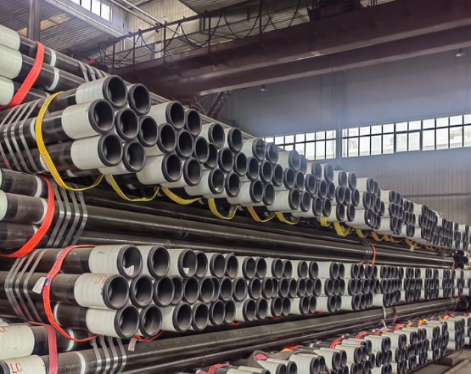ASTM A500 is a standard specification for cold-formed welded and seamless carbon steel structural tubing in round, square tube and rectangular tube shapes.
Specifications: ASTM A500 Grade B
Applications: frames, roll cages, truck racks, trailers, railings, etc.
Workability: Easy to Weld, Cut, Form and Machine
Mechanical Properties: Brinell = 63, Tensile = 58,000 +/-, Yield = 46,000 +/-

Typical Permissible Variations in Wall Thickness
The minimum wall thickness at any point of measurement on the tubing shall be not more than 10% less than the specified wall thickness. The maximum wall thickness, excluding the weld seam of welded tubing, shall be not more than 10% greater than the specified wall thickness. For square and rectangular tubing, the wall thickness requirements shall apply only to the centers of the flats.
The difference
ASTM A500 round tube, ASTM A500 square tube and ASTM A500 rectangular tube are not different in terms of material and performance, most of which are differences in cross-sectional shape and use.
Square pipes are mostly used in the construction and machinery manufacturing industries;
The rectangular tube is widely used as a pipeline for transporting fluids and manufacturing mechanical parts and engineering structures, firearms and cannons.
Compared with the round tube, the square tube has high compressive strength, low weight, and a wide range of applications.
Specifications: ASTM A500 Grade B
Applications: frames, roll cages, truck racks, trailers, railings, etc.
Workability: Easy to Weld, Cut, Form and Machine
Mechanical Properties: Brinell = 63, Tensile = 58,000 +/-, Yield = 46,000 +/-

| Typical Chemical Properties | ||||
| Grades A, B, and D – Heat analysis | Grades A, B, and D – Product analysis | Grade C – Heat analysis | Grade C – Product analysis | |
| Carbon, maximum % | 0.26 | 0.3 | 0.23 | 0.27 |
| Manganese, maximum % | 1.35 | 1.4 | 1.35 | 1.4 |
| Phosphorous, maximum, % | 0.035 | 0.045 | 0.035 | 0.045 |
| Sulfur, maximum, % | 0.035 | 0.045 | 0.035 | 0.045 |
| Copper, minimum (if Copper-containing steel is specified in the purchase order) % | 0.2 | 0.18 | 0.2 | 0.18 |
| Typical Mechanical Properties | ||||
| Round Structural Tubing | Grade A | Grade B | Grade C | Grade D |
| Tensile Strength, Minimum, psi [Mpa] | 45,000 [310] | 58,000 [400] | 62,000 [425] | 58,000 [400] |
| Yield Strength, Minimum, psi [Mpa] | 33,000 [230] | 42,000 [290] | 46,000 [315] | 36,000 [250] |
| Shaped Structural Tubing | Grade A | Grade B | Grade C | Grade D |
| Tensile Strength, Minimum, psi [Mpa] | 45,000 [310] | 58,000 [400] | 62,000 [425] | 58,000 [400] |
| Yield Strength, Minimum, psi [Mpa] | 39,000 [270] | 46,000 [315] | 50,000 [345] | 36,000 [250] |
Typical Permissible Variations in Wall Thickness
The minimum wall thickness at any point of measurement on the tubing shall be not more than 10% less than the specified wall thickness. The maximum wall thickness, excluding the weld seam of welded tubing, shall be not more than 10% greater than the specified wall thickness. For square and rectangular tubing, the wall thickness requirements shall apply only to the centers of the flats.
The difference
ASTM A500 round tube, ASTM A500 square tube and ASTM A500 rectangular tube are not different in terms of material and performance, most of which are differences in cross-sectional shape and use.
Square pipes are mostly used in the construction and machinery manufacturing industries;
The rectangular tube is widely used as a pipeline for transporting fluids and manufacturing mechanical parts and engineering structures, firearms and cannons.
Compared with the round tube, the square tube has high compressive strength, low weight, and a wide range of applications.
Previous:ASTM A106 GR B









